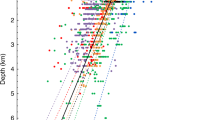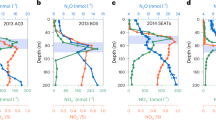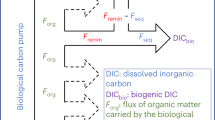Abstract
A key question when trying to understand the global carbon cycle is whether the oceans are net sources or sinks of carbon. This will depend on the production of organic matter relative to the decomposition due to biological respiration. Estimates of respiration are available for the top layers, the mesopelagic layer, and the abyssal waters and sediments of various ocean regions. Although the total open ocean respiration is uncertain, it is probably substantially greater than most current estimates of particulate organic matter production. Nevertheless, whether the biota act as a net source or sink of carbon remains an open question.
This is a preview of subscription content, access via your institution
Access options
Subscribe to this journal
Receive 51 print issues and online access
$199.00 per year
only $3.90 per issue
Buy this article
- Purchase on Springer Link
- Instant access to full article PDF
Prices may be subject to local taxes which are calculated during checkout
Similar content being viewed by others
References
Field, C. B., Behrenfeld, M. J., Randerson, J. T. & Falkowski, P. Primary production of the biosphere: Integrating terrestrial and oceanic components. Science 281, 237–240 (1998)
Longhurst, A., Sathyendranath, S., Platt, T. & Caverhill, C. An estimate of global primary production in the ocean from satellite radiometer data. J. Plankton Res. 17, 1245–1271 (1995)
Ducklow, H. W. Ocean biogeochemical fluxes: New production and export of organic matter from the upper ocean. Rev. Geophys. 33 (Suppl.), 1271–1276 (1995)
Balkanski, Y., Monfray, P., Batle, M. & Heimann, M. Ocean primary production derived from satellite data: An evaluation with atmospheric oxygen measurements. Glob. Biogeochem. Cycles 13, 257–271 (1999)
Morel, A. & Antoine, D. Small critters—big effects. Science 296, 1980–1982 (2002)
Williams, P. J. LeB. Microbial contribution to overall marine plankton metabolism: direct measurements of respiration. Oceanolog. Acta 4, 359–364 (1981)
Suess, E. Particulate organic carbon flux in the oceans—surface productivity and oxygen utilization. Nature 288, 260–263 (1980)
Karl, D. M., Hebel, D. V., Björkman, K. & Letelier, R. M. The role of dissolved organic matter release in the productivity of the oligotrophic North Pacific Ocean. Limnol. Oceanogr. 43, 1270–1286 (1998)
Lefévre, D., Denis, M., Lambert, C. E. & Miguel, J.-C. Is DOC the main source of organic matter remineralization in the ocean water column? J. Mar. Syst. 7, 281–291 (1996)
Robinson, C. et al. Plankton respiration in the eastern Atlantic Ocean. Deep-Sea Res. I 49, 787–813 (2002)
Duarte, C. M., Arístegui, J., González, N., Agustí, S. & Anadón, R. Evidence for a heterotrophic subtropical NE Atlantic. Limnol. Oceanogr. 46, 425–428 (2001)
Harrison, W. G. et al. Basin-scale variability in plankton biomass and community metabolism in the subtropical North Atlantic Ocean. Deep-Sea Res. II 48, 2241–2269 (2001)
Gonzalez, N. et al. The metabolic balance of the planktonic community at the N. Atlantic Subtropical Gyre: The role of mesoscale instabilities. Limnol. Oceanogr. 46, 946–952 (2001)
del Giorgio, P. A., Cole, J. J. & Cimbleris, A. Respiration rates in bacteria exceed plankton production in unproductive aquatic systems. Nature 385, 148–151 (1997)
Duarte, C. M. & Agustí, S. The CO2 balance of unproductive aquatic ecosystems. Science 281, 234–236 (1998)
Williams, P. J. LeB. The balance of plankton respiration and photosynthesis in the open ocean. Nature 394, 55–57 (1998)
Duarte, C. M., Agustí, S., del Giorgio, P. A. & Cole, J. J. Regional carbon imbalances in the oceans. Science 284, 1735b (1999)
Biddanda, B. & Benner, R. Major contribution from mesopelagic plankton to heterotrophic metabolism in the upper ocean. Deep-Sea Res. I 44, 2069–2085 (1997)
Moriarty, D. J. W. & O'Donohue, M. J. Organic carbon transport from the Southern Ocean and bacterial growth in the Antarctic Intermediate Water masses of the Tasman Sea. Mar. Ecol. Prog. Ser. 119, 291–297 (1995)
Serret, P., Robinson, C., Fernández, E., Teira, E. & Tilstone, G. Latitudinal variation of the balance between plankton photosynthesis and respiration in the eastern Atlantic Ocean. Limnol. Oceangr. 46, 1642–1652 (2001)
Arístegui, J. & Harrison, W. G. Decoupling of primary production and community respiration in the ocean: implications for regional carbon studies. Aquat. Microb. Ecol. (in the press)
Pomeroy, L. R. & Johannes, R. E. Occurrence respiration of ultraplankton in the upper 500 meters of the ocean. Deep-Sea Res. 15, 381–391 (1968)
Menzel, D. W. & Ryther, J. H. Organic carbon and the oxygen minimum in the South Atlantic Ocean. Deep-Sea Res. 15, 327–384 (1971)
Vidal, M., Duarte, C. M. & Agustí, S. Dissolved organic nitrogen and phosphorus pools and fluxes in the central Atlantic Ocean. Limnol. Oceanogr. 44, 106–115 (1999)
Wyrtki, K. The oxygen minima in relation to ocean circulation. Deep-Sea Res. 9, 11–23 (1962)
Garfield, P. C., Packard, T. T., Friederich, G. E. & Codispoti, L. A. A subsurface particle maximum layer and enhanced microbial activity in the secondary nitrite maximum of the northeastern tropical Pacific Ocean. J. Mar. Res. 41, 747–768 (1983)
Packard, T. T. & Williams, P. J. LeB. Rates of respiratory oxygen consumption and electron transport in surface seawater from the northwest Atlantic. Oceanolog. Acta 4, 351–358 (1981)
Packard, T. T. Respiration and respiratory electron transport activity in plankton from the Northwest African upwelling. J. Mar. Res. 65, 711–741 (1979)
Boyd, P. W. et al. Transformations of biogenic particulates from the pelagic to the deep ocean realm. Deep-Sea Res. II 46, 2761–2792 (1999)
Doval, M. D. & Hansell, D. A. Organic carbon and apparent oxygen utilization in the western South Pacific and the central Indian Oceans. Mar. Chem. 68, 249–264 (2000)
Fiadeiro, M. E. & Craig, H. Three-dimensional modeling of tracers in the deep Pacific Ocean: I. Salinity and oxygen. J. Mar. Res. 36, 323–355 (1978)
Novoselov, A. A. Studies of oxygen consumption in the northern part of the Atlantic. Okeanologiya 2, 84–92 (1962)
Hansell, D. A. & Carlson, C. A. Deep-ocean gradients in the concentration of dissolved organic carbon. Nature 395, 263–266 (1998)
Jahnke, R. The global ocean flux of particulate organic carbon: Areal distribution and magnitude. Glob. Biogeochem. Cycles 10, 71–88 (1996)
King, F. D., Devol, A. H. & Packard, T. T. Plankton metabolic activity in the eastern tropical North Pacific. Deep-Sea Res. 25, 689–704 (1978)
Joiris, C. et al. A budget of carbon cycling in the Belgian coastal zone: relative roles of zooplankton, bacterioplankton and benthos in the utilization of primary production. Netherlands J. Sea Res. 16, 260–275 (1982)
Holligan, P. M., Williams, P. J. LeB, Purdie, D. & Harris, R. P. Photosynthesis, respiration and nitrogen supply of plankton populations in stratified, frontal and tidally mixed shelf waters. Mar. Ecol. Prog. Ser. 17, 201–213 (1984)
Christensen, J. P. & Packard, T. T. Oxygen utilization and plankton metabolism in a Washington Fjord. Estuar. Coast. Mar. Sci. 4, 339–347 (1976)
Hernández-León, S. et al. Large-scale and mesoscale distribution of plankton biomass and metabolic activity in the Northeastern Central Atlantic. J. Oceanogr. 55, 471–482 (1999)
del Giorgio, P. A. & Cole, J. J. Marine Microbial Ecology (ed. Kirchman, D.) 289–325 (Plenum, New York, 2000)
Schlesinger, W. H. Biogeochemistry. An Analysis of Global Change (Academic, San Diego, 1991)
Bauer, J. E., Williams, P. M. & Druffel, E. R. M. 14C activity of dissolved organic carbon fractions in the central North Pacific and Sargasso Sea. Nature 357, 667–670 (1992)
Woodwell, G. M. et al. Biotic feedbacks in the warming of the earth. Clim. Change 40, 495–518 (1998)
Pomeroy, L. R., Wiebe, W. J., Deibel, D., Thompson, R. J. & Rowe, G. T. Bacterial responses to temperature and substrate concentration during the Newfoundland spring bloom. Mar. Ecol. Prog. Ser. 75, 143–159 (1991)
Calbet, A. Mesozooplankton grazing effect on primary production: A global comparative analysis in marine ecosystems. Limnol. Oceanogr. 48, 1824–1830 (2001)
Pauly, D. & Christensen, V. Primary production required to sustain global fisheries. Nature 374, 255–257 (1995)
Jenkins, W. & Goldman, J. Seasonal oxygen cycling and primary production in the Sargasso Sea. J. Mar. Sci. 43, 465–491 (1985)
Duarte, C. M. & Cebrián, J. The fate of marine autotrophic production. Limnol. Oceanogr. 41, 1758–1766 (1996)
Bender, M., Ellis, T., Tans, P., Francey, R. & Lowe, D. Variability in the O2/N2 ratio of the southern hemisphere air, 1991–1994: Implications for the ocean carbon cycle. Glob. Biogeochem. Cycles 10, 9–21 (1996)
Carlson, C. A., Ducklow, H. W., Hansell, D. A. & Smith, W. O. Jr Organic carbon partitioning during spring phytoplankton blooms in the Ross Sea polynya and the Sargasso Sea. Limnol. Oceanogr. 43, 375–386 (1998)
Baines, S. B. & Pace, M. L. The production of dissolved organic carbon by phytoplankton and its importance to bacteria: Patterns across marine and freshwater systems. Limnol. Oceanogr. 36, 1078–1090 (1991)
Cole, J. J., Findlay, S. & Pace, M. L. Bacterial production in fresh and saltwater ecosystems: a cross-system overview. Mar. Ecol. Prog. Ser. 43, 1–10 (1988)
Hoppe, H.-G., Gocke, K., Koppe, R. & Begler, C. Bacterial growth and primary production along a north-south transect in the Atlantic Ocean. Nature 416, 168–171 (2002)
Gattuso, J.-P., Franjignoulle, M. & Wollast, R. Carbon and carbonate metabolism in coastal aquatic ecosystems. Annu. Rev. Ecol. Syst. 29, 405–433 (1998)
Mackenzie, F. T., Lerman, A. & Ver, L. M. B. Role of the continental margin in the global carbon balance during the past three centuries. Geology 26, 423–426 (1998)
Bauer, J. E. & Druffel, E. R. M. Ocean margins as a significant source of organic matter to the deep open ocean. Nature 392, 482–485 (1998)
Meybeck, M. Carbon, nitrogen and phosphorus transport by world rivers. Am. J. Sci. 282, 401–450 (1982)
Duce, R. A. et al. The atmospheric input of trace species to the world ocean. Glob. Biogeochem. Cycles 5, 193–259 (1991)
Cornell, S., Rendell, A. & Jickells, T. Atmospheric inputs of dissolved organic nitrogen to the oceans. Nature 376, 243–246 (1995)
Kumar, N. et al. Increased biological productivity and export production in the glacial Southern Ocean. Nature 378, 675–680 (1995)
Mopper, K. et al. Photochemical degradation of dissolved organic carbon and its impact on the ocean carbon cycle. Nature 353, 60–62 (1991)
Cherrier, J., Bauer, J. E., Druffel, E. R. M., Coffin, R. B. & Chanton, J. P. Radiocarbon in marine bacteria: evidence for the ages of assimilated carbon. Limnol. Oceanogr. 44, 730–736 (1999)
Christensen, J. P. Carbon export from continental shelves, denitrification and atmospheric carbon dioxide. Continent. Shelf Res. 14, 547–576 (1994)
Sundquist, E. T. The global carbon dioxide budget. Science 259, 934–941 (1993)
Emerson, S. et al. Experimental determination of the organic carbon flux from open-ocean surface waters. Nature 389, 951–954 (1997)
Sambrotto, R. N. et al. Elevated consumption of carbon relative to nitrogen in the surface ocean. Nature 363, 248–250 (1993)
Falkowski, P. G., Barber, R. T. & Smetacek, V. Biogeochemical controls and feedbacks on ocean primary production. Science 281, 200–206 (1998)
Raich, J. W., Potter, C. S. & Bhagawati, D. Interannual variability in global soil respiration, 1980-94. Glob. Change Biol. 8, 800–812 (2002)
Takahashi, T. et al. Global sea-air CO2 flux based on climatological surface ocean pCO2, and seasonal biological and temperature effects. Deep-Sea Res. II 49, 1601–1622 (2002)
Lefèvre, N. & Taylor, A. Estimating pCO2 from sea surface temperatures in the Atlantic gyres. Deep-Sea Res. I 49, 539–554 (2002)
Smith, E. M. & Kemp, W. M. Seasonal and regional variations in plankton community production and respiration for the Chesapeake Bay. Mar. Ecol. Prog. Ser. 116, 217–231 (1995)
Rivkin, R. B. & Legendre, L. Biogenic carbon cycling in the upper ocean: effects of microbial respiration. Science 291, 2398–2400 (2001)
Acknowledgements
We thank M. Pace, T. Bouvier and E. Smith for comments on the manuscript, and particularly P. leB. Williams for extensive input; we also thank H. Canut for encouragement and S. Agustí for inspiration. This work was supported by the Spanish Plan Nacional de Investigación y Desarrollo, the Cátedra Programme of the Banco de Bilbao y Vizcaya Foundation, and the US National Science Foundation.
Author information
Authors and Affiliations
Corresponding author
Rights and permissions
About this article
Cite this article
del Giorgio, P., Duarte, C. Respiration in the open ocean. Nature 420, 379–384 (2002). https://doi.org/10.1038/nature01165
Issue Date:
DOI: https://doi.org/10.1038/nature01165
This article is cited by
-
Metabolic balance in the euphotic layer of Lake Sagami, Japan
Limnology (2024)
-
Functional and structural responses of plankton communities toward consecutive experimental heatwaves in Mediterranean coastal waters
Scientific Reports (2023)
-
Vision-based techniques for automatic marine plankton classification
Artificial Intelligence Review (2023)
-
Pulsed export of carbon in the north-western Mediterranean Sea
Journal of Oceanology and Limnology (2023)
-
Accounting for variation in temperature and oxygen availability when quantifying marine ecosystem metabolism
Scientific Reports (2022)
Comments
By submitting a comment you agree to abide by our Terms and Community Guidelines. If you find something abusive or that does not comply with our terms or guidelines please flag it as inappropriate.



